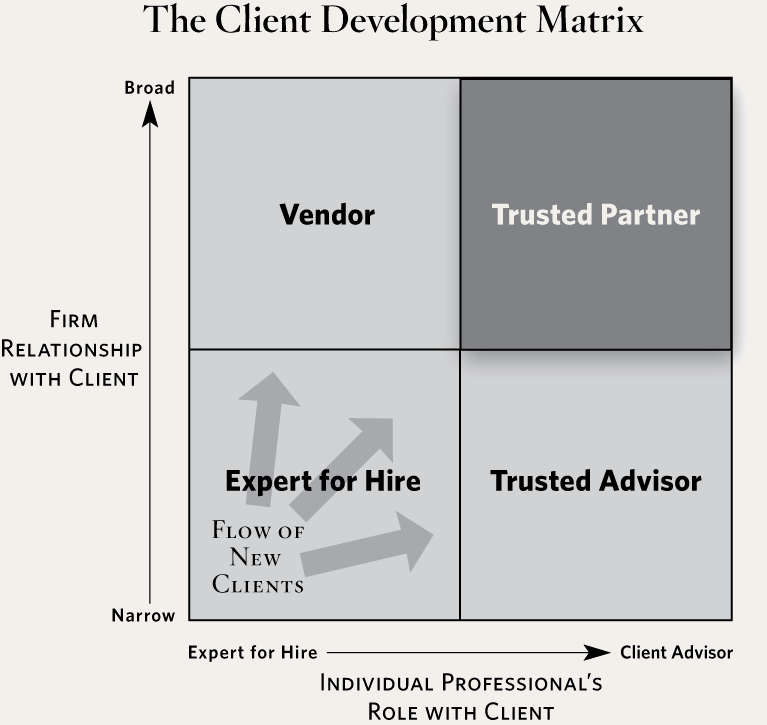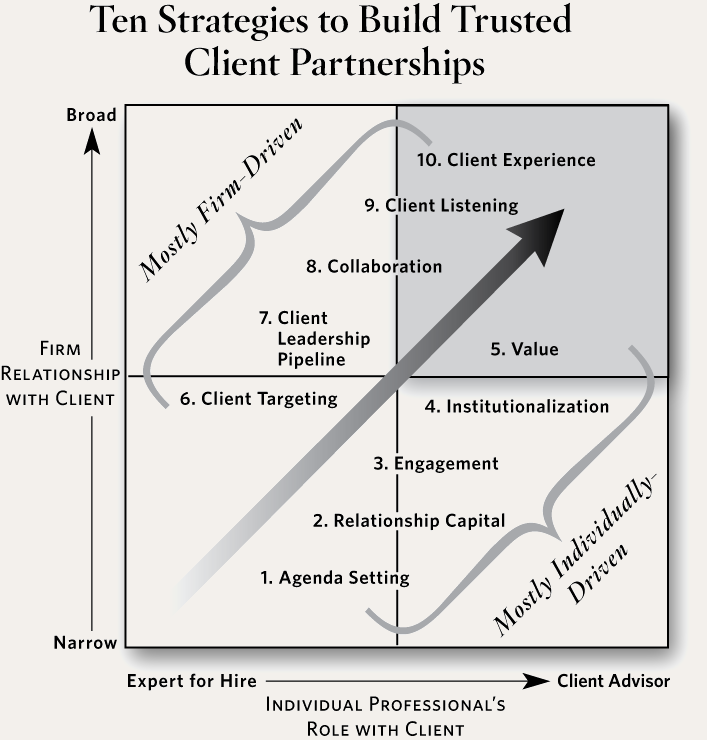Watch Andrew’s Video: The Five Pitfalls of Relationship Management
Client Relationship Management
From Expert for Hire to Trusted Partner
Competition, commoditization, client sophistication, and transparent markets mean that few services can be truly differentiated in their own right. Strong, enduring client relationships, therefore, are the lifeblood of most organizations. Long term relationships serve another key function in today’s tumultuous markets: they reduce risk for both clients and service providers.

It’s not easy, however, to develop and sustain trusted client relationships. I consistently hear two major concerns from the leaders of service firms in a variety of sectors, from consulting to accounting to banking. First, “How can we improve the relationship-building skills of our front-line relationship managers (i.e, account executives, partners, managing directors, and so on) so that they are able to build deeper, more resilient relationships at senior levels; and second “How can we more effectively mobilize our complete capabilities, across the organization, to create enduring, institutionalized client relationships? Intensifying these challenges are ever-increasing client demands for more value in their relationships with external service providers.
The relationships that most professional firms aspire to build lie in what I call the Northeast Quadrant. In this space, two things have happened: first, the individual professional managing the relationship has evolved his or her role from an expert-for-hire to a trusted business advisor; and second, the firm has developed its overall relationship from a narrow one based on few services and one individual contact to a broad one founded on multiple relationships and services. These Northeast Quadrant relationships— we can also call them trusted client partnerships—are the bedrock of most organizations.
These two key dimensions are portrayed on the client development matrix. The X axis shows the journey of the individual professional, while the Y axis illustrates the firm or company journey in supporting the development of trusted partnerships.
A given client relationship can be approximately positioned in the matrix by asking a few simple questions. The matrix distinguishes four different positions, each with its own characteristics:
FIRST: Expert for Hire: This is where most relationships begin. At this point, the trust and mutual understanding that might deepen and broaden the relationship simply have not developed yet. This is not a “bad” position to be in, but probably not one where you want to remain for long.
SECOND: Trusted Advisor: In this quadrant, you’ve demonstrated a series of qualities— trustworthiness, independence, judgment, big-picture thinking, empathy, and others—that earn you a position as a trusted advisor within your client’s inner circle. You are, metaphorically, an architect who helps the client develop a vision or strategy but who is not involved in implementation—in building the house itself. This is a great role to play, but without moving up the other axis and broadening the relationship at a firm level, your ability to grow this client will be severely limited.
THIRD: Vendor: You’ve successfully broadened the relationship and developed a significant revenue stream with this client. You may in fact be managing a very large, multifaceted program. Don’t kid yourself, however—you’re still in “RFP territory,” just as you were when you were a solitary expert for hire.
FOURTH: Trusted Partner: This is the ultimate goal: to be a trusted advisor to your client and to harness the full power of your organization to deliver outstanding results. In this top-right quadrant you have built a true client partnership. You are leading your client’s agenda, have built many-to-many relationships, and are meeting an array of client needs. It’s not an easy task to play this role with a client, but if you succeed, you and your firm will probably have a client for life—and a highly profitable one at that. You’ll also experience great personal satisfaction in the role of a trusted counselor who is having a significant impact on his or her client’s success.
What enables the development of “Northeast Quadrant” client partnerships?
Over the last 15 years, I have conducted extensive research into the ingredients of successful, enduring client relationships. I have also worked closely with many leading professional service firms, technology companies, and financial services institutions on this topic. It’s clear to me that there are approximately 10 major building blocks—essential strategies or practices—that are necessary to evolve from an expert-for-hire to a trusted advisor to, finally, a trusted client partner. These building blocks, properly executed, enable you to move firmly into the Northeast Quadrant of the client development matrix.

Some of these building blocks are principally driven by the client relationship manager or account executive. For example:
- Developing relationship capital. Each client-facing professional has the responsibility of building a strong network of what I call “relationship hubs”—those critical, few individuals who can really make a difference. A firm’s total relationship capital is, naturally, the sum of all of these.
- Becoming an agenda setter. Experts for hire are reactive—they respond to client requests for work. Trusted partners are agenda setters—they understand, align with, support, and help improve the client’s agenda of critical priorities and goals.
- Institutionalizing the relationship. A variety of strategies must be brought to bear to accomplish this, including creating many-to-many relationships, building a team with the right mix of “deep generalists” and subject-matter experts, and engaging in systematic account planning and development.
Other building blocks must be principally driven at the firm level. For example:
Creating a trusted advisor pipeline. For every 100 professionals hired, only a few will eventually be able to go on and manage major client relationships. How do you systematically select, retain, and develop relationship managers who can take on this critical responsibility 8 or 10 years down the road?
- Fostering firm-wide collaboration. There are a number of factors which can encourage collaboration across boundaries, as well as obstacles that prevent collaboration. It is the responsibility of senior management to manage these factors and deliberately foster familiarity and trust and the frictionless movement of people, ideas, and resources into major client relationships.
For each of these 10 building blocks, I have developed a comprehensive framework which outlines the essential tasks, best practices, and implementation tools required for succcess. Please contact me if you’d like to discuss any aspect of client relationship management in more depth.